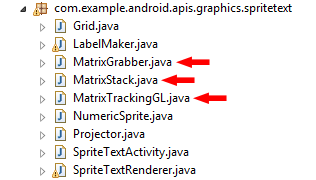Programming
- page 23Unity3D: JavaScript vs. C# – Part 2
Posted by Dimitri | Nov 29th, 2010
Part 2 of a post series that tries to explain the differences between JavaScript and C# when programming for the Unity3D game engine. It is recommended that you read part one before continuing. In this post, I will explain how to access other GameObjects and Components. This is one of he most common tasks that a programmer has to perform when writing scripts for Unity3D game engine. So, let’s start by assuming that we want to retrieve a GameObject named ‘Pawn’ which is at the root of the scene and has a script called ‘PawnMover’ attached to it.
Getting the GameObject using JavaScript is simple. All you have to do is to call the GameObject class Find() static method and pass the name of the other GameObject we want as a parameter: Continue reading: “Unity3D: JavaScript vs. C# – Part 2”
Android OpenGL: Get the ModelView Matrix on Cupcake (1.5)
Posted by Dimitri | Nov 25th, 2010
One of the most annoying things when developing apps with OpenGL in Android 1.5, is the fact that there’s no access to the ModelView or the Projection matrices. It is not possible to call the glGetFloatv function because it wasn’t implemented until OpenGL ES 1.1, which isn’t available in the Cupcake versions. So, how to get the ModelView matrix on Android 1.5? The first thing you are going to do is grab these three classes: MatrixGrabber, MatrixStack and MatrixTrackingGL. All of them are inside the API demos, under the package com.example.android.apis.graphics.spritetext.

You're going to need these.
Continue reading: “Android OpenGL: Get the ModelView Matrix on Cupcake (1.5)”
Unity3D: JavaScript vs. C# – Part 1
Posted by Dimitri | Nov 5th, 2010
This is the first post of a series that will discuss some differences between JavaScript and C# when programming for Unity3D game engine. A project with all the scripts used in these posts will be available for download in the last post of the series. So let’s start from the start and see some of the main differences between the two languages.
The first and most easily distinguishable is the notation used to declare variables and methods. When programming in JavaScript, it isn’t necessary to declare the variable or method type whether in C#, it’s a must. That is because JavaScript is a weakly typed language, meaning that the interpreter chooses the best type to use at compilation-time. C# is a totally different because it is strongly typed, so, the type has to be declared before a variable or method. Let’s see some examples to better grasp this concept. The following script is a JavaScript example: Continue reading: “Unity3D: JavaScript vs. C# – Part 1”
Android OpenGL: Texture from Canvas
Posted by Dimitri | Nov 2nd, 2010
Another post about Android programming, although this time, it’s going to incorporate some OpenGL techniques. The code below shows how to draw a Canvas into a Bitmap, and then, load it as a OpenGL texture object. This means that it is possible to use all Canvas methods to draw into a texture, like drawCircle(), drawPoints() or drawText(). This is useful to render text to a texture and to dynamically generate textures.
So here’s the code: Continue reading: “Android OpenGL: Texture from Canvas”


